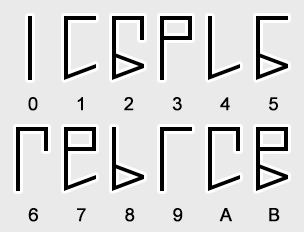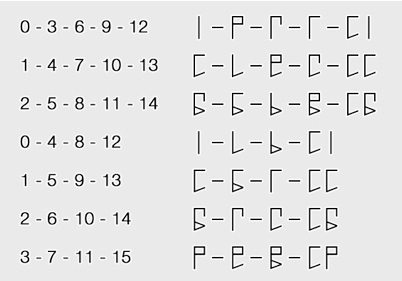004 Syncopated Dozenic

This system has a pattern, but it’s a little harder to find. If we separate the glyphs into top and bottom portions, the pattern is easily seen...

The upper portions of the numerals, cycle in a pattern of 4, while the lower potions cycle in 3. This system will require complete memorization before it can be used fluently. This prompts the question, why would we use it then? I suspect there could be some benefits...

Here is an interesting pattern. Starting from any number, counting in threes will retain the lower portion of the numeral, while the upper portion cycles in reverse order. Counting in fours will retain the upper portion of the numeral, while the lower portion cycles forward.

There might also be benefits using this system with music. One example is shown above. This is an important pattern used in music, ‘The Circle of Fifths’. The chromatic pattern is 0, 7, 2, 9, 4, 11, 6, 1, 8, 3, 10, 5. In syncopated dozenic, we can instantly create this sequence by reversing the cycle in the upper portions of the numerals.


The above examples show earlier variants of this numeral system. Similar to binquadric and trincubic, the numerals are arranged in a cross-referencing matrix system. This can be done as 3 sets of 4, or as 4 sets of 3. I couldn’t decide which method to use, though, which is what led me to experimenting with a shared syncopated pattern.
I suspect there are undiscovered mathematical patterns when cycling three against four, instead of by matrix. I’m hoping that this can lead to simpler methods of conversion between base sixteen and base twenty-seven, though I do plan to keep experimenting with all three variants. You never know what you may find...


I’ve also been experimenting with other writing variations. The variants above are simpler to write with a pen. The original variant seemed to have a mix of simple and complex looking numerals, while these look less cluttered, more smoothly flowing. On the downside, they do deviate from the logical polygonal structure of the original system.

